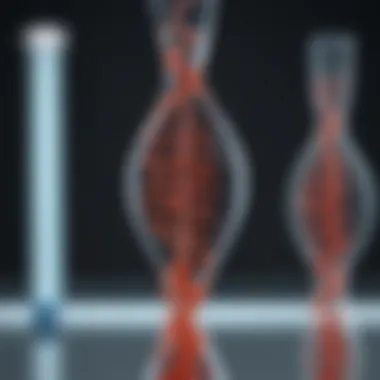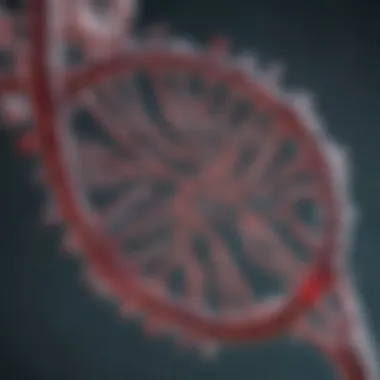Isolation of Circulating Cell-Free DNA: Techniques & Applications


Intro
Circulating cell-free DNA (cfDNA) has become a central topic within molecular biology and clinical diagnostics. Its isolation from biological fluids such as blood or plasma is crucial for understanding various diseases. This section aims to provide an overview of cfDNA, its significance, and the nuances involved in its isolation techniques. By unpacking the foundational concepts, we can appreciate the technical challenges and the advancements made in this field.
Key Concepts
Definition of Primary Terms
Circulating cell-free DNA (cfDNA) refers to the DNA fragments that are released into the bloodstream from cells undergoing apoptosis or necrosis, as well as from active secretion processes. These fragments can vary in size and are typically short, ranging from about 100 to 200 base pairs.
The importance of cfDNA lies in its potential as a biomarker. It can provide insights into tumor biology, organ transplant rejection, and other pathological conditions. Its non-invasive nature makes it a preferred choice for diagnostics compared to traditional tissue biopsies.
Related Concepts and Theories
Several theories underpin the significance of cfDNA in medical diagnostics. For instance, the tumor heterogeneity model explains how cfDNA can reflect the genetic landscape of tumors. This model underscores the potential for cfDNA to inform treatment decisions, particularly in cancer therapy.
Additionally, apoptotic mechanisms provide a backdrop for understanding how and why cfDNA is released into circulation. Studies have shown that a significant amount of cfDNA originates from apoptotic cells, making its analysis indicative not only of cancer presence but also of other conditions related to cell death.
Current cfDNA Isolation Techniques
The techniques for isolating cfDNA have evolved rapidly. Common methodologies include:
- Phenol-Chloroform Extraction: A traditional method often regarded as the gold standard, although it can be labor-intensive and less safe due to the toxic chemicals used.
- Silica-Based Columns: A popular and more efficient technique which utilizes spin columns for rapid extraction but may face challenges related to inhibitor co-extraction.
- Magnetic Bead-Based Methods: These offer high efficiency and yield, often becoming the choice for high-throughput applications.
Each of these methods has its advantages and limitations that researchers must consider.
Future Directions
Gaps Identified in Current Research
Despite the advancements, several gaps remain in cfDNA research. For example, the relationship between cfDNA characteristics and specific disease states is not fully understood. Additionally, while various isolation methods exist, their comparative effectiveness in different clinical scenarios is not sufficiently explored.
Suggestions for Further Studies
Future research could focus on optimizing isolation techniques to improve yield and purity of cfDNA. Moreover, integrating cfDNA sequencing technologies could enhance our understanding of its implications in precision medicine.
"Enhanced isolation protocols could significantly impact patient outcomes by enabling more accurate diagnostics."
A comprehensive review of cfDNA characteristics in diverse biological contexts can also provide deeper insights into its utility as a clinical tool.
Prolusion to Circulating Cell-Free DNA
Circulating cell-free DNA, commonly abbreviated as cfDNA, has gained significant attention in various medical and research fields. This interest stems from its potential to provide insights into health and disease through non-invasive methods. The presence of cfDNA in bodily fluids, such as blood, offers a unique opportunity to monitor biological processes and disease states.
In this article, we will explore the definition, origin, and biological roles of cfDNA, set the stage for understanding its isolation techniques. The focus will be on techniques available for isolating cfDNA, assessing its quality, and the various applications in clinical settings.
The significance of cfDNA isolation lies in its broad application in diagnostics, particularly in oncology, prenatal testing, and disease monitoring. This method allows for the analysis of genetic material without the need for invasive procedures like biopsies, thus reducing patient risk and discomfort. Understanding cfDNA helps researchers and clinicians unlock valuable information about tumor dynamics, fetal health, and infectious diseases.
Additionally, there are critical considerations in cfDNA research, including sample collection, proper isolation methodology, and quality control. These aspects play a crucial role when interpreting results and determining clinical outcomes.
Defining cfDNA
Circulating cell-free DNA refers to DNA fragments that are found in the bloodstream and other body fluids, which are not associated with living cells. Their sizes typically range from 160 to 200 base pairs, forming a result of cellular apoptosis and necrosis. They originate from various tissues within the body and may carry genetic information that reflects the overall health status of the patient.
This nucleic acid can exist in different forms, including fragments shed from malignant tumors or from normal cellular processes. The detection and analysis of cfDNA can reveal significant insights into pathophysiological conditions, helping to refine diagnostic practices and therapeutic approaches.


Origin and Biological Role
The origin of cfDNA is multifaceted, primarily arising from cellular turnover within tissues. During normal physiological processes, cells undergo apoptosis, leading to the release of DNA fragments into circulation. In pathological conditions, particularly in cancer, cfDNA levels can be considerably higher due to increased cell death, resulting from tumor growth and treatment response.
The biological role of cfDNA is still under investigation. However, it is hypothesized that cfDNA may serve as a biological marker, reflecting tissue health and integrity. The analysis of cfDNA can provide insights into genetic alterations associated with diseases, making it a valuable tool for understanding tumor biology, progression, and potential treatment efficacy. This understanding lays the groundwork for exploring isolation techniques that will be discussed in the following sections.
"The isolation and characterization of cfDNA has the potential to transform modern diagnostics by enabling early detection and real-time monitoring of disease without invasive interventions."
Overall, the study of cfDNA is at the forefront of precision medicine, offering a glimpse into the future of diagnostic and therapeutic strategies. Shifting the focus to the methods to isolate cfDNA will further elucidate its vast potential in clinical applications.
Techniques for cfDNA Isolation
The ability to isolate circulating cell-free DNA (cfDNA) is crucial in a variety of research and clinical settings. Techniques for cfDNA isolation can significantly affect the yield and quality of the extracted DNA. Choosing the right method depends on the sample type, the desired purity, and the research purpose. Understanding the principles and applications of these techniques is fundamental for researchers and clinicians aiming to utilize cfDNA effectively.
Ultracentrifugation
Ultracentrifugation is one of the oldest and most widely used methods for isolating cfDNA. It relies on high rotational speeds to separate components based on density. In this process, blood plasma or serum is first prepared, and then subjected to rapid rotation in a centrifuge. This allows lighter components like cfDNA to separate from heavier proteins and cellular debris.
The advantages of ultracentrifugation include high yield and purity of cfDNA. However, it does require specialized equipment and can be time-consuming. Moreover, improper operation might lead to DNA shearing, compromising the integrity of the cfDNA.
Precipitation Methods
Precipitation methods for cfDNA isolation typically use organic solvents or salts to cause cfDNA to aggregate. The most common precipitants are alcohols, like ethanol or isopropanol. Initially, the sample undergoes a treatment to destabilize proteins and cellular particles, allowing the cfDNA to remain in solution. Then, adding the precipitant leads to cfDNA falling out of solution upon centrifugation.
These methods are advantageous due to their simplicity and cost-effectiveness. However, they might not always yield the highest purity due to residual contaminants from the sample. Additionally, some cfDNA may be lost during the washing steps, leading to lower yields.
Magnetic Bead-Based Isolation
Magnetic bead-based isolation has gained popularity due to its efficiency and sensitivity. In this technique, specially coated magnetic beads bind to cfDNA. This allows for easy separation from the sample when exposed to a magnetic field. The process is relatively straightforward: the sample is mixed with magnetic beads, and centrifugation followed by washing steps ensures the removal of contaminants.
One notable advantage of this method is the rapid processing time. Moreover, it provides high yields and purity, making it suitable for various applications, including next-generation sequencing. However, the choice of beads and the binding efficiency can vary, requiring optimization for specific applications.
Column-Based Isolation Techniques
Column-based isolation techniques utilize silica membranes or similar materials to capture cfDNA from the sample. This process usually involves lysing the cells, followed by transferring the lysate to a column. When a wash buffer is applied, cfDNA binds to the column matrix, allowing other components to be washed away. Elution with a low-salt buffer provides the purified cfDNA.
These techniques are known for their efficiency and consistency. They provide a solid yield and are often preferred in clinical settings. However, the potential for carryover contamination from previous samples and the need for specific materials may limit their accessibility.
Comparison of Isolation Techniques
With several techniques available, it is useful to compare them based on specific metrics:
- Yield: Magnetic bead-based methods often provide the highest yields, while precipitation methods may result in losses.
- Purity: Ultracentrifugation and column-based techniques generally lead to purer cfDNA.
- Time Efficiency: Magnetic bead approaches are typically faster, while ultracentrifugation is more time-consuming.
- Cost: Precipitation methods are the most cost-effective, while column and magnetic bead methods might require more investment.
Quality Assessment of Isolated cfDNA
Quality assessment of circulating cell-free DNA (cfDNA) is crucial in ensuring the reliability of downstream applications. The presence of cfDNA in biofluids like blood provides significant information regarding disease states, yet the quality of the isolated DNA can vary significantly. This variability can originate from the isolation method used, sample handling, and even the biological variations among individuals. Thus, evaluating the quantity, integrity, and purity of isolated cfDNA becomes essential for achieving accurate results in research and clinical diagnostics.
Quantification Techniques
Quantification techniques for cfDNA play a vital role in ensuring that sufficient quantities are available for analysis. Common methods include:
- Qubit Fluorometer: This method uses fluorescent dyes specific to DNA, providing high sensitivity and specificity in quantifying low concentrations of cfDNA.
- Quantitative PCR (qPCR): qPCR allows for the quantification of certain cfDNA sequences by amplifying them. This technique is particularly useful for assessing target sequences relevant to specific diseases.
- NanoDrop Spectrophotometer: While less sensitive than other methods, the NanoDrop provides a quick estimate of DNA concentration and purity using absorbance measurements.
Each of these methods offers unique advantages, and the choice often depends on the specific application and the nature of the sample.
Integrity Analysis


Analyzing the integrity of cfDNA is essential to confirm its suitability for various applications. The integrity of cfDNA can be assessed using:
- Gel Electrophoresis: By running isolated cfDNA on an agarose gel, researchers can visually assess the size and degradation of DNA fragments. Intact cfDNA tends to yield distinct bands, while degraded samples show a smear.
- Bioanalyzer: This automated tool provides a comprehensive profile of cfDNA integrity, presenting a distribution of fragment sizes that indicates the quality of the isolated DNA.
Maintaining high integrity is crucial as fragmented cfDNA might not be suitable for applications like next-generation sequencing or accurate quantitative PCR.
Purity Determination
Determining the purity of cfDNA is as important as quantification and integrity analysis. Contaminants such as proteins, RNA, and free nucleotides can interfere with downstream applications. Common methods for determining purity include:
- A260/A280 Ratio Measurement: This simple spectrophotometric method analyzes absorbance at 260 nm and 280 nm. A ratio of 1.8 is generally regarded as pure DNA. Lower values may indicate protein contamination.
- A260/A230 Ratio Measurement: This analysis is also performed with a spectrophotometer to assess contamination with phenol, chloroform, or other organic compounds. Values close to 2.0 are indicative of high purity.
Careful assessment through these techniques ensures that researchers are working with high-quality cfDNA, leading to more reliable results in their research activities.
Comprehensive quality assessment of cfDNA is essential to enhance the reliability of findings in molecular diagnostics and to support personalized medicine initiatives effectively.
Applications of cfDNA Isolation
The relevance of circulating cell-free DNA (cfDNA) in the realm of molecular diagnostics cannot be overstated. cfDNA has become a crucial feature in various clinical applications, providing insights that significantly influence patient care and treatment strategies. The areas of oncology research, prenatal screening, transplantation monitoring, and infectious disease diagnosis stand out as substantial domains where cfDNA isolation plays a transformative role.
Understanding how cfDNA is utilized across these fields unveils the depth of its application and helps demystify its significance in advancing medical science.
Oncology Research
Oncology research has seen a remarkable shift with the introduction of cfDNA analysis. Tumors shed DNA fragments into the bloodstream, enabling researchers to obtain vital information about the presence and progression of cancer without invasive biopsy procedures. This liquid biopsy method not only enhances patient comfort but also allows for real-time monitoring of tumor dynamics.
Key benefits of cfDNA in oncology include:
- Early Detection: cfDNA provides a non-invasive avenue for detecting tumors at an earlier stage compared to traditional imaging techniques.
- Monitoring Treatment Response: Measuring cfDNA levels can indicate how well a patient responds to specific therapies, facilitating timely adjustments in treatment plans.
- Understanding Resistance Mechanisms: Analyzing cfDNA can reveal mutations that confer resistance to treatment, guiding personalized therapies.
In summary, cfDNA isolation is an instrumental technique in oncology, aiding in diagnosis, treatment adjustment, and patient management.
Prenatal Screening
Prenatal screening is another critical application of cfDNA isolation. It allows for the non-invasive assessment of fetal genetic conditions early in pregnancy. A sample of maternal blood contains cfDNA from both mother and fetus, which can be analyzed to detect chromosomal abnormalities such as Down syndrome.
The advantages of cfDNA in prenatal screening include:
- Non-Invasive: Unlike invasive procedures such as amniocentesis, cfDNA screening avoids risks to both mother and fetus.
- High Accuracy: cfDNA screening results exhibit high sensitivity and specificity, offering reliable information on fetal genetic health.
- Wider Accessibility: As cfDNA testing becomes more available, it promises to democratize access to prenatal genetic information.
cfDNA isolation in prenatal testing thus plays an essential role in modern obstetric care, providing crucial information while minimizing risks.
Transplantation Monitoring
The realm of transplantation has also benefitted immensely from cfDNA isolation techniques. Post-transplant, the presence of donor-derived cfDNA in the recipient's bloodstream can serve as an indicator of organ transplant rejection or injury. By analyzing the cfDNA, clinicians can monitor organ health in a non-invasive manner.
Key aspects of cfDNA use in transplantation monitoring include:
- Biomarker for Rejection: Elevated levels of donor-derived cfDNA may signify early signs of transplant rejection.
- Timely Interventions: cfDNA analysis enables healthcare providers to decide on interventions proactively, enhancing transplant outcomes.
- Avoiding Invasive Procedures: Monitoring can be achieved without frequent biopsies, contributing to better patient comfort and compliance.
This application exemplifies how cfDNA isolation has transformed the management of transplantation, enhancing patient safety and treatment efficacy.
Infectious Disease Diagnosis
cfDNA isolation has emerged as a valuable tool in the diagnosis of infectious diseases. It can help identify pathogens by detecting their genetic material in the bloodstream. This rapid diagnostic approach can be crucial for timely treatment decisions.
The benefits of applying cfDNA in infectious disease diagnosis can include:


- Rapid Results: cfDNA isolation allows for quicker diagnosis compared to traditional culture methods, which may take longer.
- Broad Detection Scope: It can be used to detect various pathogens, including bacteria and viruses, broadening the diagnostic landscape.
- Monitoring Disease Progression: Continuous analysis of cfDNA can provide insights into the progression of an infection and guide therapeutic decisions.
Infectious disease diagnostics, powered by cfDNA methods, enables advanced management of infections, especially in critical cases.
By understanding the applications of cfDNA isolation, we gain insight into its substantial impact across different fields. Such knowledge reinforces its significance as a versatile tool in addressing various medical challenges.
Limitations and Challenges in cfDNA Isolation
The isolation of circulating cell-free DNA (cfDNA) is accompanied by various limitations and challenges. Recognizing these obstacles is essential for both researchers and clinicians who aim to leverage cfDNA in diagnostics and therapeutics. This section elaborates on significant issues that can affect the efficiency and reliability of cfDNA isolation results. It is crucial to address these challenges to improve methodologies and enhance the potential of cfDNA as a biomarker in clinical settings.
Sample Contamination
Sample contamination remains a critical concern during cfDNA isolation. Contamination can occur at various stages, from sample collection to processing. It's imperative to use proper techniques to minimize this risk. For instance, using sterile collection tubes and gloves can reduce the introduction of exogenous DNA. Moreover, environmental factors, such as airborne particles or cross-contamination from laboratory surfaces, can also contribute to this issue. The presence of extraneous DNA can skew results, leading to false interpretations regarding the quantity or origin of cfDNA. Thus, researchers must implement rigorous protocols to maintain sample integrity and prevent contamination.
Important Note: Ensuring sample purity is vital for accurate cfDNA analysis. Contaminated samples can compromise clinical decisions and research outcomes.
Low Concentration of cfDNA
The concentration of cfDNA in biological fluids can be quite low, presenting another significant challenge. Typical concentrations vary greatly depending on the source, such as plasma, serum, or urine. In many cases, the levels of cfDNA are insufficient for downstream applications, which limits quantitative analyses. This low concentration can result from physiological conditions or the stage of the disease in question. As such, it becomes necessary to optimize isolation techniques that can effectively enrich cfDNA without compromising quality. Advanced methodologies need to be developed to enhance the yield of cfDNA extraction to facilitate more sensitive analyses.
Standardization Issues
Standardization of protocols for cfDNA isolation is essential but often lacking. Currently, various methods exist, and discrepancies among different laboratories can lead to variability in results. This inconsistency can undermine the reproducibility of findings, which is crucial for clinical validation and general application of cfDNA as a biomarker. There is also a need for established guidelines that encompass all stages of cfDNA isolation. Such guidelines would ensure uniformity in sample handling, processing, and analysis. By addressing these standardization issues, researchers can improve collaboration and data comparability across different studies, ultimately supporting the advancement of the field.
In summary, while cfDNA isolation holds considerable promise in various applications, it is imperative to confront the limitations and challenges discussed. Addressing sample contamination, enhancing cfDNA yield, and creating standardized methods are crucial steps for improving the overall reliability and applicability of cfDNA analysis in both research and clinical scenarios.
Future Directions in cfDNA Research
The exploration of circulating cell-free DNA (cfDNA) has gained momentum due to its promise in diagnostics and personalized medicine. Researchers are increasingly recognizing the potential of cfDNA to offer insights into various disease mechanisms. It is crucial to examine the future directions in cfDNA research to better understand how these studies can evolve and optimize applications in clinical settings. This part highlights advancements, applications, and ethical considerations for cfDNA research that will shape its trajectory.
Technological Innovations
Technological innovations are at the forefront of advancing cfDNA research. New methods and tools are being developed to enhance the sensitivity and specificity of cfDNA analysis. For instance, improvements in next-generation sequencing technology allow for more comprehensive genome profiling. This progression contributes to the identification of disease-specific mutations with increased accuracy.
In addition to sequencing advancements, microfluidic devices are proving to be valuable for cfDNA isolation. These devices enable efficient capture and processing of cfDNA from small blood volumes, reducing patient discomfort and increasing accessibility. Furthermore, automated cfDNA extraction kits are emerging. These help streamline workflows in laboratories, improve reproducibility, and lessen the labor intensity associated with manual techniques.
Personalized Medicine Applications
The relevance of cfDNA in personalized medicine cannot be overstated. Individual variability in cfDNA profiles can provide critical information for tailoring treatments specific to a patient’s genetic makeup. For example, in oncology, cfDNA analysis can assist in monitoring tumor evolution and therapy response. This aids clinicians in making informed decisions on treatment adjustments.
Moreover, cfDNA is an essential component in developing liquid biopsies. These non-invasive tests obtain genetic information from bodily fluids, circumventing the need for invasive tissue biopsies. Liquid biopsies can significantly improve patient experience and increase screening rates for various cancers.
As the integration of cfDNA into routine clinical practice expands, researchers are exploring its use in areas beyond oncology. Cardiovascular diseases and transplant rejection monitoring are promising fields where cfDNA analysis could yield new insights and influence patient care decisions.
Ethical Considerations
As advancements in cfDNA research unfold, ethical considerations must be addressed. The collection and analysis of cfDNA raise important questions regarding patient consent and data privacy. Patients must be informed about how their cfDNA will be used in diagnostic processes and potential research. Transparency in this regard is vital for maintaining trust between patients and healthcare providers.
Another ethical issue pertains to the accessibility of cfDNA testing. If these technologies become widely adapted in clinical practice, inequities in access may arise. Policymakers and researchers must work together to ensure that advancements are equitably distributed across different populations.
Additionally, discussions surrounding the potential misuse of genetic information derived from cfDNA are warranted. Safeguards must be established to prevent discrimination based on genetic profiles in insurance and employment contexts. Overall, ethical considerations must keep pace with technological developments to create a responsible framework for cfDNA research.
"The integration of cfDNA into clinical practice poses both opportunities and challenges; ongoing discussions about ethics and access are essential."
Epilogue
The isolation of circulating cell-free DNA (cfDNA) represents a significant advancement in the realm of molecular diagnostics and translational medicine. As outlined throughout this article, various techniques for cfDNA isolation have demonstrated their potential utility across multiple fields, including oncology, prenatal screening, transplantation monitoring, and infectious disease diagnosis. The ability to analyze cfDNA allows for non-invasive insights into disease states, enabling more personalized approaches to patient care.
The primary benefit of cfDNA isolation techniques lies in their capability to provide a snapshot of the underlying biological processes occurring in the body. For example, detecting mutations in tumor-derived cfDNA can inform treatment decisions in oncology, while monitoring cfDNA levels in transplant recipients can help to assess graft rejection risk. These examples underline the relevance and applicability of isolating cfDNA.
Yet, the field continues to face challenges. Sample contamination, the low concentration of cfDNA, and standardization issues may hinder the reliability and effectiveness of results. As discussed, addressing these hurdles is crucial for advancing cfDNA research. Future innovations, particularly technological breakthroughs, hold promise for enhancing isolation methods, thereby increasing sensitivity and specificity in clinical use.
Furthermore, ethical considerations surrounding cfDNA analysis warrant careful deliberation. Ensuring patient privacy and informed consent is imperative given the sensitive nature of genetic information.



